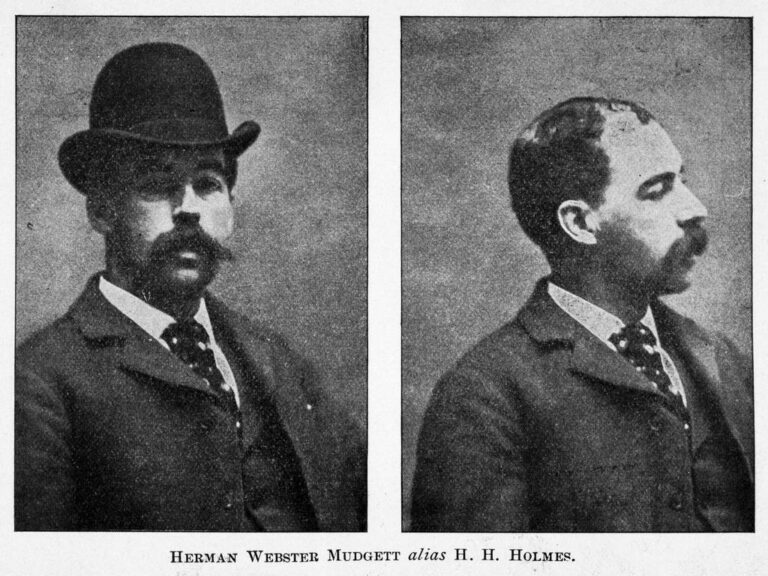In the city’s history, the World’s Columbian Exposition of 1893 is perhaps one of its grandest moments — Chicago’s emergence on the world stage as a new metropolis rising from the ashes of a great fire just 22 years prior.
But in recent years, the city’s finest hour has been inextricably intertwined with its first serial killer, the dapper and duplicitous H.H. Holmes, thanks largely to Erik Larson’s wildly popular 2003 novel “The Devil in the White City.”
On the 130th year since Daniel Burnham’s sweeping transformation of Chicago’s southern lakefront into the classical alabaster-columned “White City,” the tales of Holmes’ dealings here, including his so-called “Murder Castle” in the Englewood neighborhood, remain largely sensational tabloid fabrications. Differing accounts claim that Holmes may have had hundreds of victims who were tortured and killed within any of the building’s network of secret rooms.
Local historians and researchers have cast doubt on many of the most outlandish actions attributed to Holmes and his 63rd Street three-flat, including the popular theory that he lured and discreetly killed dozens of victims and disposed of them in the basement of his property.
Holmes’ former building at 610 W. 63rd St., which initially had a drugstore on the ground floor and rooms on the second floor before a third story was later constructed, did indeed have secret rooms and a walk-in vault that was “mostly” soundproof. But it likely was used to conceal stolen furniture rather than murder, experts say.
“The real story is actually more complicated and it’s not simply not just true or false … he did use (the building) to commit crimes, but probably not a lot of the crimes that people think,” said Paul Durica, a historian with the Chicago History Museum.
Born Herman Webster Mudgett in New Hampshire, Holmes was a charming, handlebar-mustachioed grifter and bigamist who arrived in Chicago in 1885 after studying in medical school, and styled himself a doctor and pharmacist in the years before the fair.
Books and documentaries have portrayed the womanizing Holmes as a ghoulish stalker and predator who lured single young women in town for the sprawling lakeside fair to his rooming house, where they mysteriously disappeared.
After his conviction for killing his business partner, Benjamin Pitezel, Holmes confessed to killing 27 people, most of them fabrications, experts say. Holmes denied killing Pitezel’s three young children, whom he shuttled around the country and Canada by railroad following the insurance scam that left their father dead. The bodies of Pitezel’s daughters, Annie and Nellie, were found in Toronto, while the remains of his son, Ben, were found in Indianapolis.
Holmes, who was only convicted in Pitezel’s murder, is suspected of killing several people during his time in Chicago but left the city in summer 1894 before he was linked to any murders. It was only after his subsequent arrest in Boston and confessions that his Chicago activities were scrutinized.
“He did kill nine or 10 people, but it wasn’t hundreds and hundreds. It wasn’t in a hotel, and it wasn’t World’s Fair patrons,” said author and Chicago tour guide Adam Selzer, whose 2017 book “H.H. Holmes: The True History of the White City Devil,” sought to demystify the killer behind the legend, using official records and documents.
[ Is ‘Devil in White City’ buried in tomb? Remains to be unearthed to find out ]
Holmes’ confessions are what likely fed his legend. Since then, media and pop culture has reimagined Holmes as an American equivalent to Jack the Ripper. Some have even speculated that Holmes was the London lady-killer.
“He was a swindler, first and foremost, who partly through his own confessions, became a new American tall tale,” Selzer said.
“Whatever he said about himself, whichever way he tried to portray himself after he had been incarcerated, is most likely fiction,” Durica said. “It seems to be, by and large, if he did murder individuals, it was for financial purposes, or to protect himself.”
Even the Tribune peddled in rumors, reprinting a New York World tabloid story in an August 1895 Sunday edition that called Holmes “Bluebeard” after the legendary wife killer. The story, published as Holmes awaited trial in Philadelphia, included numerous falsehoods that would become the basis of Holmes’ legend, including a drawn diagram of his “castle,” complete with trap doors, hidden chambers and a crematory.
Durica said that immediately following Holmes’ death, most news reports focused on Holmes’ greed rather than a clear compulsion to kill. He theorized that Holmes was retroactively painted as a killer by people’s expanding knowledge of killers.
“We think, in hindsight, of him as a psychopath, a serial killer. But he was probably … if we were going to diagnose him today, we’d say he’s closer to a sociopath. A con artist. A grifter. A perennial liar,” Durica said. “Murder was a means to an end, but it had to serve a practical purpose. It wasn’t something he just engaged in because he had some overwhelming passion to commit these horrible acts.”

Vintage Chicago Tribune
Weekly
The Vintage Tribune newsletter is a deep dive into the Chicago Tribune’s archives featuring photos and stories about the people, places and events that shape the city’s past, present and future.
This sentiment was shared by Selzer, who has done one of the deepest dives into Holmes’ past for his 2017 book. In his book, Selzer, who operates the Mysterious Chicago tours and who examined the basement of Holmes’ former home, which partially sits below the current Englewood post office, dispels a number of Holmes myths, including the notion that he silently murdered dozens of people in the bustling community of Englewood.
The murder castle did have hidden rooms between floors accessible by dumbwaiter and a secret staircase. The sensational World article claimed the dumbwaiters were used to lower bodies to the basement, but Selzer and Durica said the elevators were used to hide furniture Holmes purchased on credit and hid from repossession agents. Holmes’ building had a nearly soundproof vault, but Selzer said there was no evidence that victims were gassed in airtight rooms or dismembered in a basement lab.
In addition to the 63rd Street property, Holmes was known to frequent a glass-bending business near what is now Seeley Avenue near Fullerton Avenue in what is now Bucktown, where some had theorized Holmes dumped some victims.
“Holmes had probably disposed of a couple of bodies in the basement, then decided that destroying a body in a crowded building without arousing suspicion was impossible,” Selzer wrote. “You really just can’t have bodies decomposing in your basement without people noticing the odor. He probably tried it a few times, then decided to dispose of any bodies he found on his hands elsewhere, perhaps first in the shack, then in the glass-bending factory on the North Side.”
The myths surrounding Holmes persist today partially because of the true crime zeitgeist permeating pop culture, Durica said, comparing it with the enduring popularity of gangster Al Capone.
“What’s interesting about both Holmes and Capone is the whole kind of like cottage industries have sprung up around them. ‘The Devil in the White City’ sort of launched it with Holmes, but since that book came out you’ve got television documentaries, multiple ones. You’ve got all sorts of bus and walking tours that are designed around the Holmes story. That’s what you find with Capone as well. Books, films, tours, merchandise,” he said. “In both cases, it makes it easier for the fiction to kind of overtake the fact.”







